The Influence of Annealing Temperature on the Morphology of Structures and the Mechanical Properties of Prequenching—Quenching and Partitioning Steel
Abstract
:1. Introduction
2. Experimental Procedure
3. Results
3.1. Microstructures of QQ&P and Q&P Samples
3.2. Mechanical Properties of QQ&P and Q&P Samples
4. Discussion
4.1. The Effect of Annealing Temperature on the Morphology of Ferrite in QQ&P and Q&P Samples
4.2. The Effect of Annealing Temperature on the Morphology, Size, and Content of Retained Austenite in QQ&P and Q&P Samples
4.3. The Relationship between Microstructures and Mechanical Properties of QQ&P Samples and Q&P Samples
4.3.1. The Influence of Microstructures on Uniform Elongations of QQ&P and Q&P Samples
4.3.2. The Effect of Microstructures on Post−Necking Elongation of QQ&P and Q&P Samples
5. Conclusions
- (1)
- At annealing temperatures of 780 °C and 810 °C, the ferrite and the retained austenite in QQ&P samples are laths and blocky, while those in Q&P samples are mainly blocky. With the increase in the annealing temperature, the morphology, volume fraction, and carbon content of retained austenite in QQ&P samples become increasingly close to that in Q&P samples.
- (2)
- At annealing temperatures of 780 °C and 810 °C, the volume fraction and carbon content of retained austenite in QQ&P samples are higher than that in Q&P samples. Meanwhile, the total elongation and PSE of QQ&P samples are significantly higher than those of Q&P samples. With the increase in the annealing temperature, the difference between QQ&P samples and Q&P samples in terms of volume fraction and carbon content of retained austenite, total elongation, and PSE decreases gradually.
- (3)
- The higher total elongation and PSE of the QQ&P samples at annealing temperatures of 780 °C and 810 °C are mainly attributed to the fact that lath structures are conducive to carbon diffusion, which can improve the thermal stability and volume fraction of retained austenite in QQ&P samples. Meanwhile, the lath structures can delay the local stress concentration and inhibit the formation of voids and microcracks.
Author Contributions
Funding
Institutional Review Board Statement
Informed Consent Statement
Data Availability Statement
Acknowledgments
Conflicts of Interest
References
- Speer, J.; Matlock, D.K.; De Cooman, B.C.; Schroth, J.G. Carbon partitioning into austenite after martensite transformation. Acta Mater. 2003, 51, 2611–2622. [Google Scholar] [CrossRef]
- Speer, J.G.; Matlock, D.K.; Cooman, B.C.D.; Schroth, J.G. Comments on “On the definitions of paraequilibrium and orthoequi−librium” by M. Hillert and J. Ågren, Scripta Materialia, 50, 697–9 (2004). Scr. Mater. 2005, 52, 83–85. [Google Scholar]
- Tan, X.D.; Xu, Y.B.; Ponge, D.; Yang, X.L.; Hu, Z.P.; Fei, F.; Ju, X.W.; Wu, D.; Raabe, D. Effect of intercritical deformation on mi-crostructure and mechanical properties of a low−silicon aluminum−added hot−rolled directly quenched and partitioned steel. Mater. Sci. Eng. A 2016, 656, 200–215. [Google Scholar] [CrossRef]
- Liu, L.; He, B.; Cheng, G.; Yen, H.; Huang, M. Optimum properties of quenching and partitioning steels achieved by balancing fraction and stability of retained austenite. Scr. Mater. 2018, 150, 1–6. [Google Scholar] [CrossRef]
- Finfrock, C.B.; Clarke, A.J.; Thomas, G.A.; Clarke, K.D. Austenite stability and strain hardening in C-Mn-Si quenching and parti−tioning steels. Metall. Mater. Trans. A 2020, 51, 2025–2034. [Google Scholar] [CrossRef]
- Shi, J.; Cao, W.; Dong, H. Ultrafine Grained High Strength Low Alloy Steel with High Strength and High Ductility. Mater. Sci. Forum 2010, 654–656, 238–241. [Google Scholar] [CrossRef]
- Cao, W.; Wang, C.; Shi, J.; Wang, M.; Hui, W.; Dong, H. Microstructure and mechanical properties of Fe-0.2C-5Mn steel processed by ART-annealing. Mater. Sci. Eng. A 2011, 528, 6661–6666. [Google Scholar] [CrossRef]
- Yan, S.; Li, T.; Liang, T.; Liu, X. Adjusting the microstructure evolution, mechanical properties and deformation behaviors of Fe-5.95Mn-1.55Si-1.03Al-0.055C medium Mn steel by cold−rolling reduction ratio. J. Mater. Res. Technol. 2019, 9, 1314–1324. [Google Scholar] [CrossRef]
- Zhang, J.; Ding, H.; Misra, R.; Wang, C. Enhanced stability of retained austenite and consequent work hardening rate through pre−quenching prior to quenching and partitioning in a Q–P microalloyed steel. Mater. Sci. Eng. A 2014, 611, 252–256. [Google Scholar] [CrossRef]
- Xiong, X.; Chen, B.; Huang, M.; Wang, J.; Wang, L. The effect of morphology on the stability of retained austenite in a quenched and partitioned steel. Scr. Mater. 2013, 68, 321–324. [Google Scholar] [CrossRef]
- Mandal, G.; Ghosh, S.; Bera, S.; Mukherjee, S. Effect of partial and full austenitisation on microstructure and mechanical properties of quenching and partitioning steel. Mater. Sci. Eng. A 2016, 676, 56–64. [Google Scholar] [CrossRef]
- Kang, T.; Zhao, Z.; Liang, J.; Guo, J.; Zhao, Y. Effect of the austenitizing temperature on the microstructure evolution and me−chanical properties of Q&P steel. Mater. Sci. Eng. A 2020, 771, 138584. [Google Scholar]
- Zhao, Z.; Liang, J.; Zhao, A.; Tang, D.; Gao, Y. Effects of the austenitizing temperature on the mechanical properties of cold−rolled medium−Mn steel system. J. Alloys Compd. 2016, 691, 51–59. [Google Scholar] [CrossRef]
- Chen, H.; Xu, X.; Xu, W.; Van Der Zwaag, S. Predicting the Austenite Fraction After Intercritical Annealing in Lean Steels as a Function of the Initial Microstructure. Met. Mater. Trans. A 2014, 45, 1675–1679. [Google Scholar] [CrossRef]
- Wu, Y.; Wang, L.; Sun, W.; Styles, M.; Studer, A.; Bréchet, Y.; Arlazarov, A.; Hutchinson, C. Austenite formation kinetics from multicomponent cementite−ferrite aggregates. Acta Mater. 2020, 196, 470–487. [Google Scholar] [CrossRef]
- Su, Y.; Chiu, L.; Chuang, T.; Wu, C.; Liao, K. Retained Austenite Amount Determination Comparison in JIS SKD11 Steel Using Quantitative Metallography and X−Ray Diffraction Methods. Adv. Mater. Res. 2012, 482–484, 1165–1168. [Google Scholar] [CrossRef]
- Van Dijk, N.H.; Butt, A.M.; Zhao, L.; Sietsma, J.; Offerman, S.E.; Wright, J.P.; Van Der Zwaag, S. Thermal stability of retained austenite in TRIP steels studied by synchrotron X−ray diffraction during cooling. Acta Mater. 2005, 53, 5439–5447. [Google Scholar] [CrossRef]
- Santofimia, M.J.; Zhao, L.; Sietsma, J. Microstructural Evolution of a Low−Carbon Steel during Application of Quenching and Partitioning Heat Treatments after Partial Austenitization. Met. Mater. Trans. A 2008, 40, 46–57. [Google Scholar] [CrossRef]
- Santofimia, M.J.; Petrov, R.H.; Zhao, L.; Sietsma, J. Microstructural analysis of martensite constituents in quenching and parti−tioning steels. Mater. Character. 2014, 92, 91–95. [Google Scholar] [CrossRef]
- HajyAkbary, F.; Sietsma, J.; Miyamoto, G.; Kamikawa, N.; Petrov, R.H.; Furuhara, T.; Santofimia, M.J. Analysis of the me−chanical behavior of a 0.3C−1.6Si−3.5Mn (wt%) quenching and partitioning steel. Mater. Sci. Eng. A 2016, 677, 505–514. [Google Scholar] [CrossRef]
- Shi, J.; Xu, H.; Zhao, J.; Cao, W.; Wang, C.; Wang, C.; Li, J.; Dong, H. Effect of austenization temperature on the microstructure evolution of the medium manganese steel (0.2C−5Mn) during ART−annealing. Acta Metall. Sin. 2012, 25, 111–123. [Google Scholar]
- Wang, C.; Shi, J.; Wang, C.; Hui, W.; Wang, M.; Dong, H.; Cao, W. Development of ultrafine lamellar ferrite and austen−ite duplex structure in 0.2C5Mn steel during ART−annealing. ISIJ Int. 2011, 51, 651–656. [Google Scholar] [CrossRef]
- Gomez, M.; Medina, S.F.; Valles, P. Determination of Driving and Pinning Forces for Static Recrystallization during Hot Rolling of a Niobium Microalloyed Steel. ISIJ Int. 2005, 45, 1711–1720. [Google Scholar] [CrossRef]
- Yang, D.; Brown, E.L.; Matlock, D.K.; Krauss, G. Ferrite recrystallization and austenite formation in cold−rolled intercritically annealed steel. Met. Mater. Trans. A 1985, 16, 1385–1392. [Google Scholar] [CrossRef]
- Li, Y.; Liu, D.; Chen, D.; Kang, J.; Wang, X.; Yuan, G.; Misra, R.D.K.; Wang, G. Response of retained austenite to quenching temperature in a novel low density Fe−Mn−Al−C steel processed by hot rolling−air cooling followed by non−isothermal parti−tioning. Mater. Sci. Eng. A 2019, 753, 197–207. [Google Scholar] [CrossRef]
- Ding, R.; Tang, D.; Zhao, A.; Guo, H.; He, J.; Zhi, C. Effect of ultragrain refinement on quenching and partitioning steels manufactured by a novel method. Mater. Des. 2015, 87, 640–649. [Google Scholar] [CrossRef]
- HajyAkbary, F.; Sietsma, J.; Miyamoto, G.; Furuhara, T.; Santofimia, M.J. Interaction of carbon partitioning, carbide precipita−tion and bainite formation during the Q&P process in a low C steel. Acta Mater. 2016, 104, 72–83. [Google Scholar]
- Chen, Z.; Gu, J.; Han, L. Decomposition characteristic of austenite retained in GCr15 bearing steel modified by addition of 1.3 wt.% silicon during tempering. J. Mater. Res. Technol. 2019, 8, 157–166. [Google Scholar] [CrossRef]
- Bhandarkar, D.; Zackay, V.F.; Parker, E.R. Stability and mechanical properties of some metastable austenitic steels. Met. Mater. Trans. A 1972, 3, 2619–2631. [Google Scholar] [CrossRef]
- Dong, H.; Cao, W.; Shi, J.; Wang, C.; Wang, M.; Weng, Y. Microstructure and performance control technology of the 3rd generation auto sheet seels. Iron. Steel. 2011, 46, 1–11. (In Chinese) [Google Scholar]
- Sun, B.; Fazeli, F.; Scott, C.; Guo, B.; Aranas, C., Jr.; Chu, X.; Jahazi, M.; Yue, S. Microstructural characteristics and tensile behavior of medium manganese steels with different manganese additions. Mater. Sci. Eng. A 2018, 729, 496–507. [Google Scholar] [CrossRef]
- Saeglitz, M.; Krauss, G. Deformation, fracture, and mechanical properties of low−temperature−tempered martensite in SAE 43xx steels. Met. Mater. Trans. A 1997, 28, 377–387. [Google Scholar] [CrossRef]
- Xie, Z.; Ren, Y.; Zhou, W.; Yang, J.; Shang, C.; Misra, R.D.K. Stability of retained austenite in multi−phase microstruc−ture during austempering and its effect on the ductility of a low carbon steel. Mater. Sci. Eng. A 2014, 603, 69–75. [Google Scholar] [CrossRef]
- Yi, H.; Chen, P.; Bhadeshia, H.K.D.H. Optimizing the Morphology and Stability of Retained Austenite in a δ−TRIP Steel. Met. Mater. Trans. A 2014, 45, 3512–3518. [Google Scholar] [CrossRef]
- Zhou, Q.; Qian, L.; Tan, J.; Meng, J.; Zhang, F. Inconsistent effects of mechanical stability of retained austenite on ductility and toughness of transformation−induced plasticity steels. Mater. Sci. Eng. A 2013, 578, 370–376. [Google Scholar] [CrossRef]
- Sun, S.; Zhao, A. Effect of microstructure morphology on mechanical properties of quenching and partitioning steel. Mater. Sci. Technol. 2017, 34, 347–354. [Google Scholar] [CrossRef]
- De Knijf, D.; Petrov, R.; Föjer, C.; Kestens, L.A. Effect of fresh martensite on the stability of retained austenite in quenching and partitioning steel. Mater. Sci. Eng. A 2014, 615, 107–115. [Google Scholar] [CrossRef]
- Tian, H.; Xin, J.; Li, Y.; Wang, X.; Cui, Z. Combined effect of cathodic potential and sulfur species on calcareous deposition, hydrogen permeation, and hydrogen embrittlement of a low carbon bainite steel in artificial seawater. Corros. Sci. 2019, 158, 108089. [Google Scholar] [CrossRef]
- Xu, Y.; Tan, X.; Yang, X.; Hu, Z.; Peng, F. Microstructure evolution and mechanical properties of a hot−rolled directly quenched and partitioned steel containing proeutectoid ferrite. Mater. Sci. Eng. A 2014, 607, 460–475. [Google Scholar] [CrossRef]
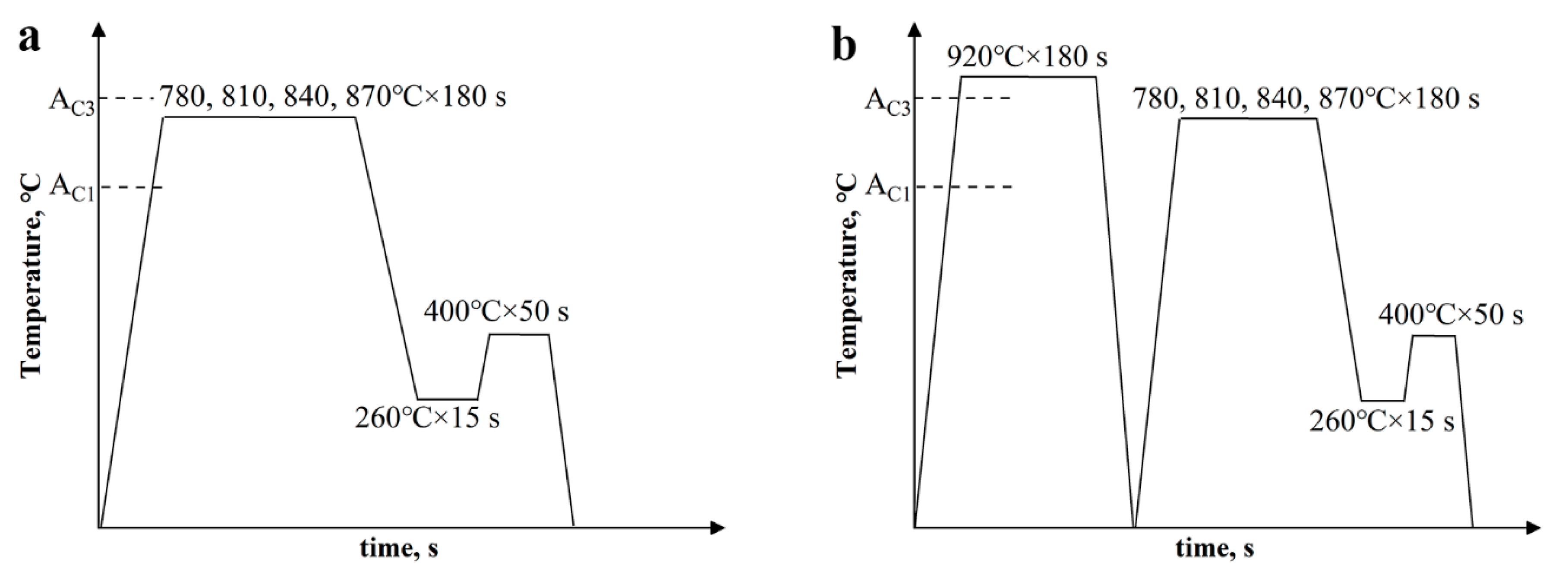
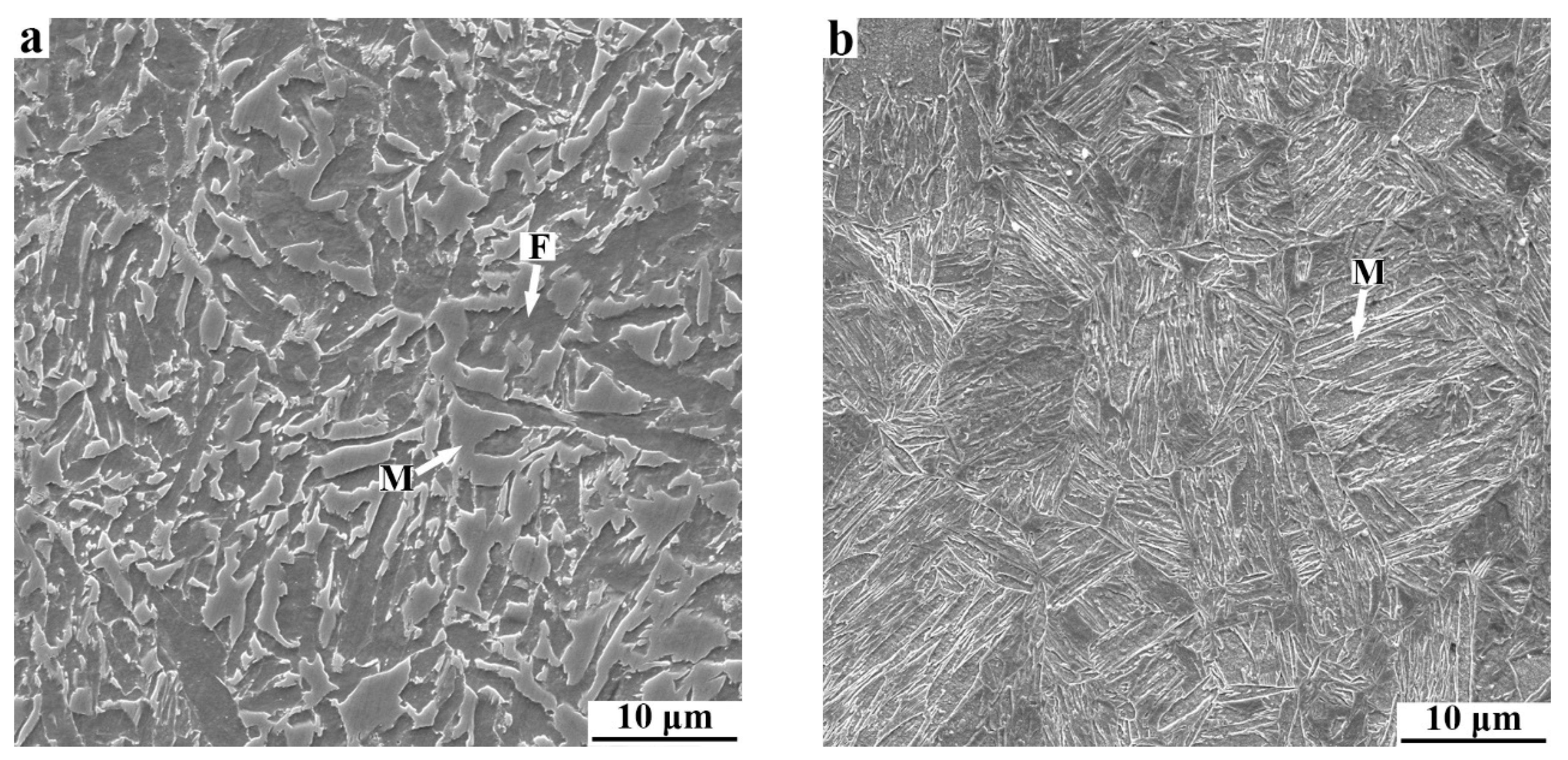

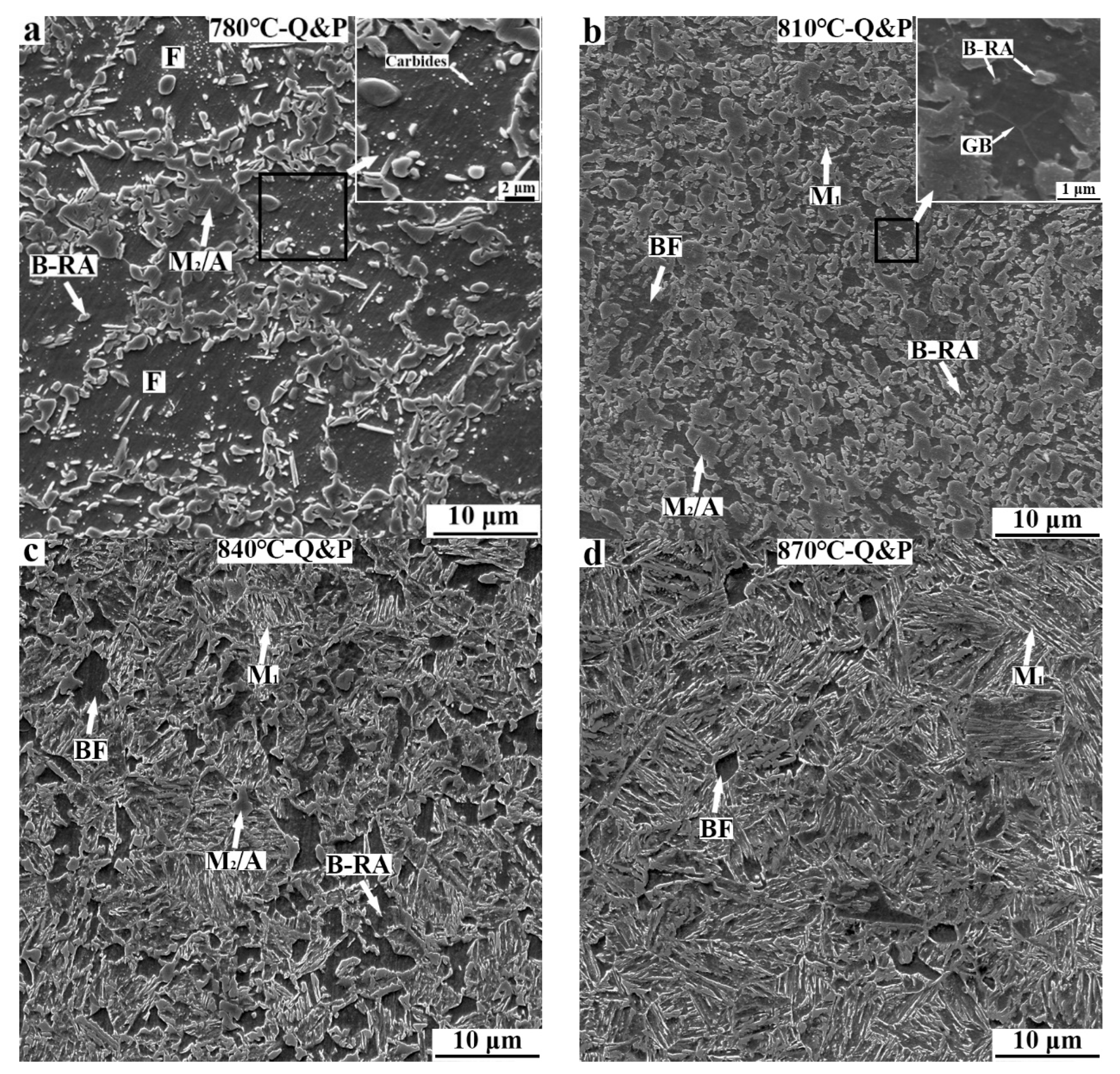
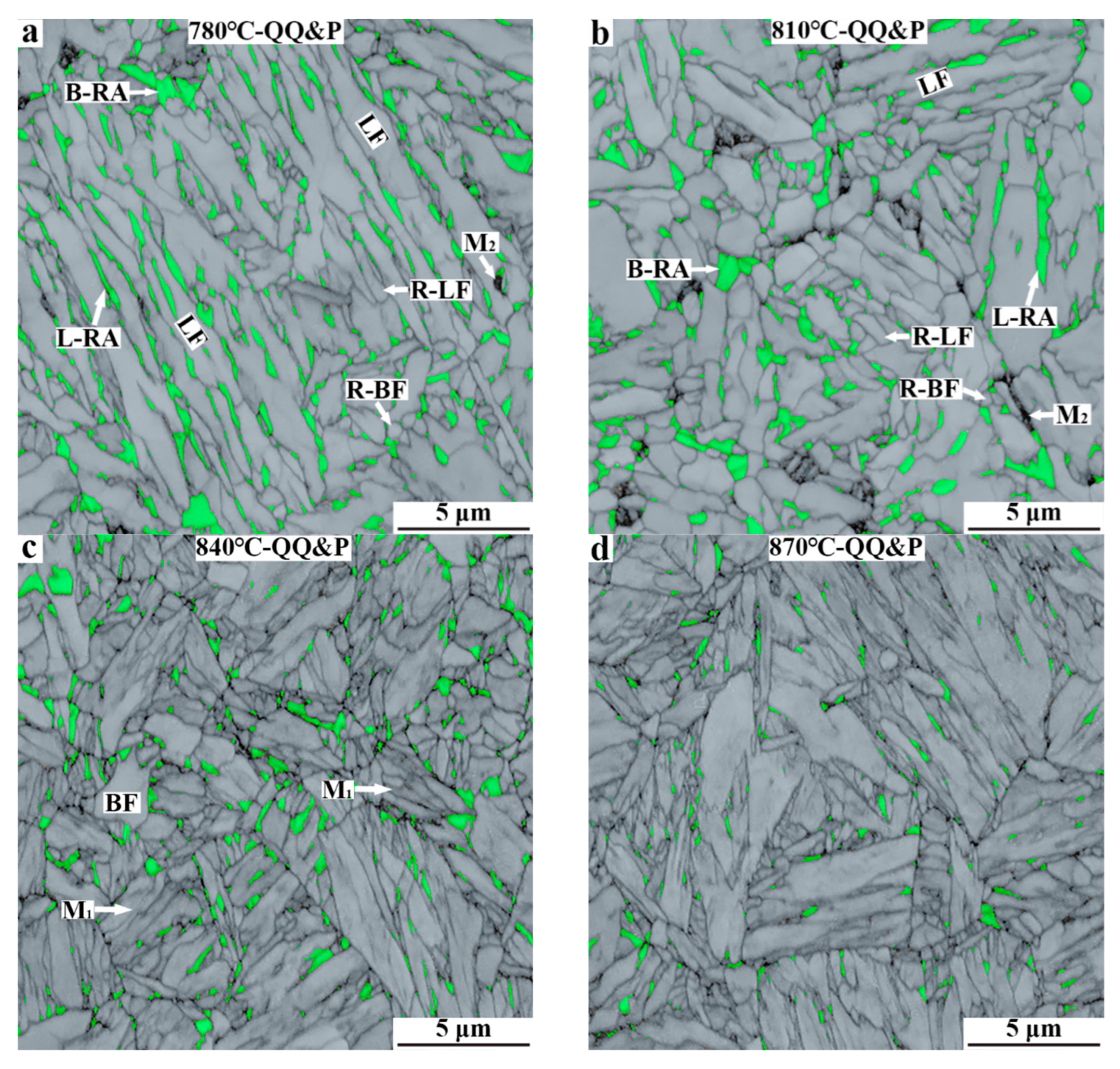
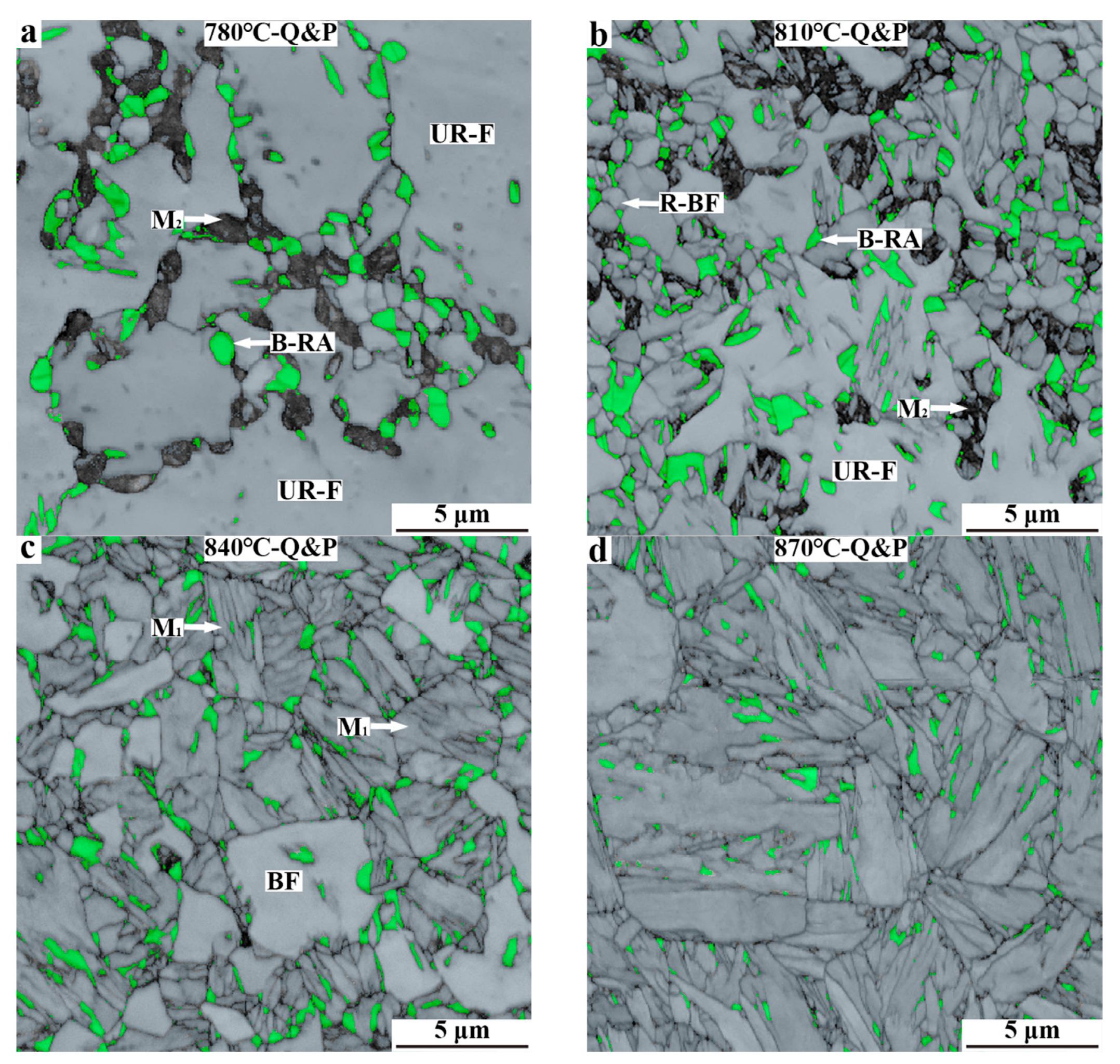
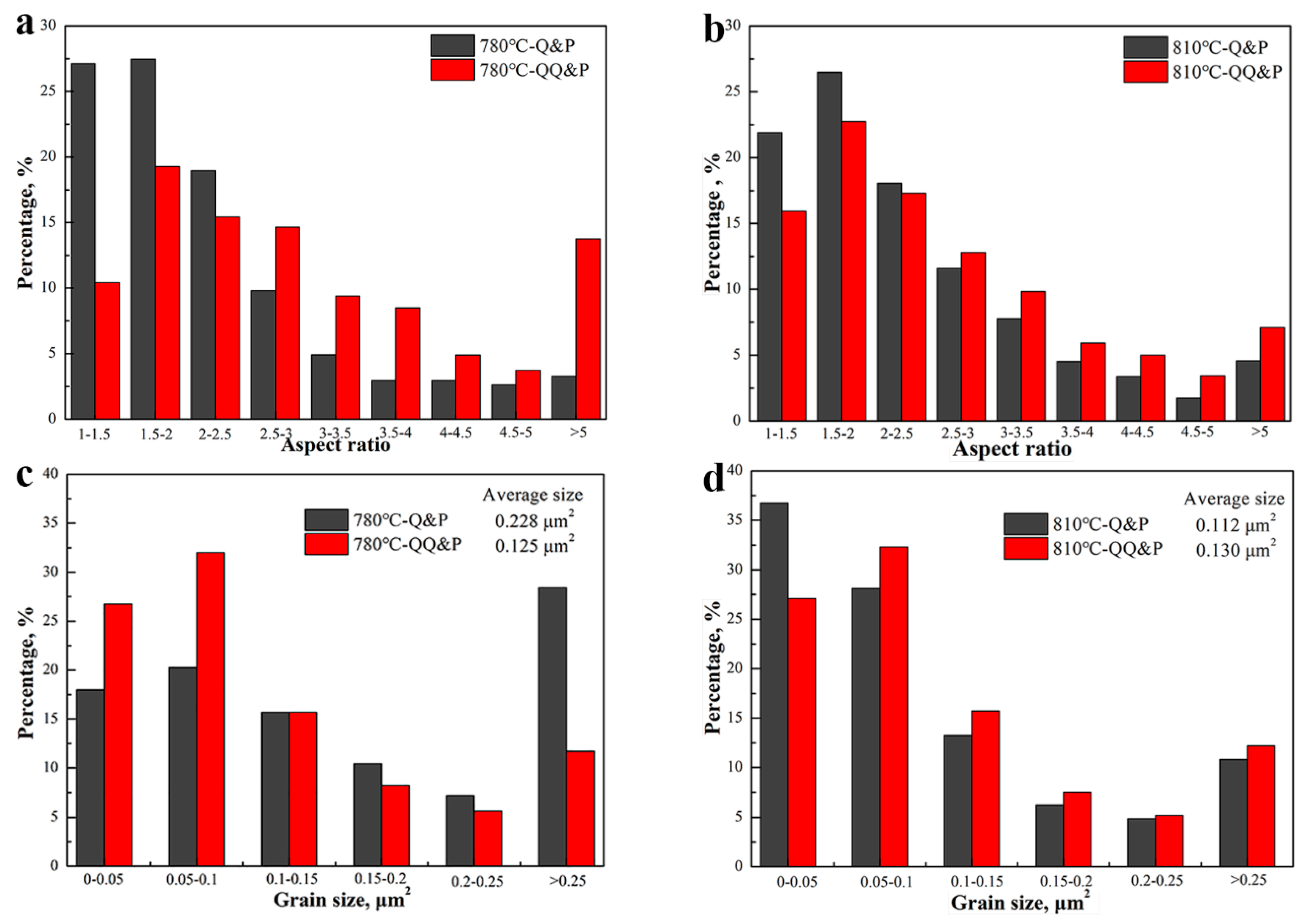
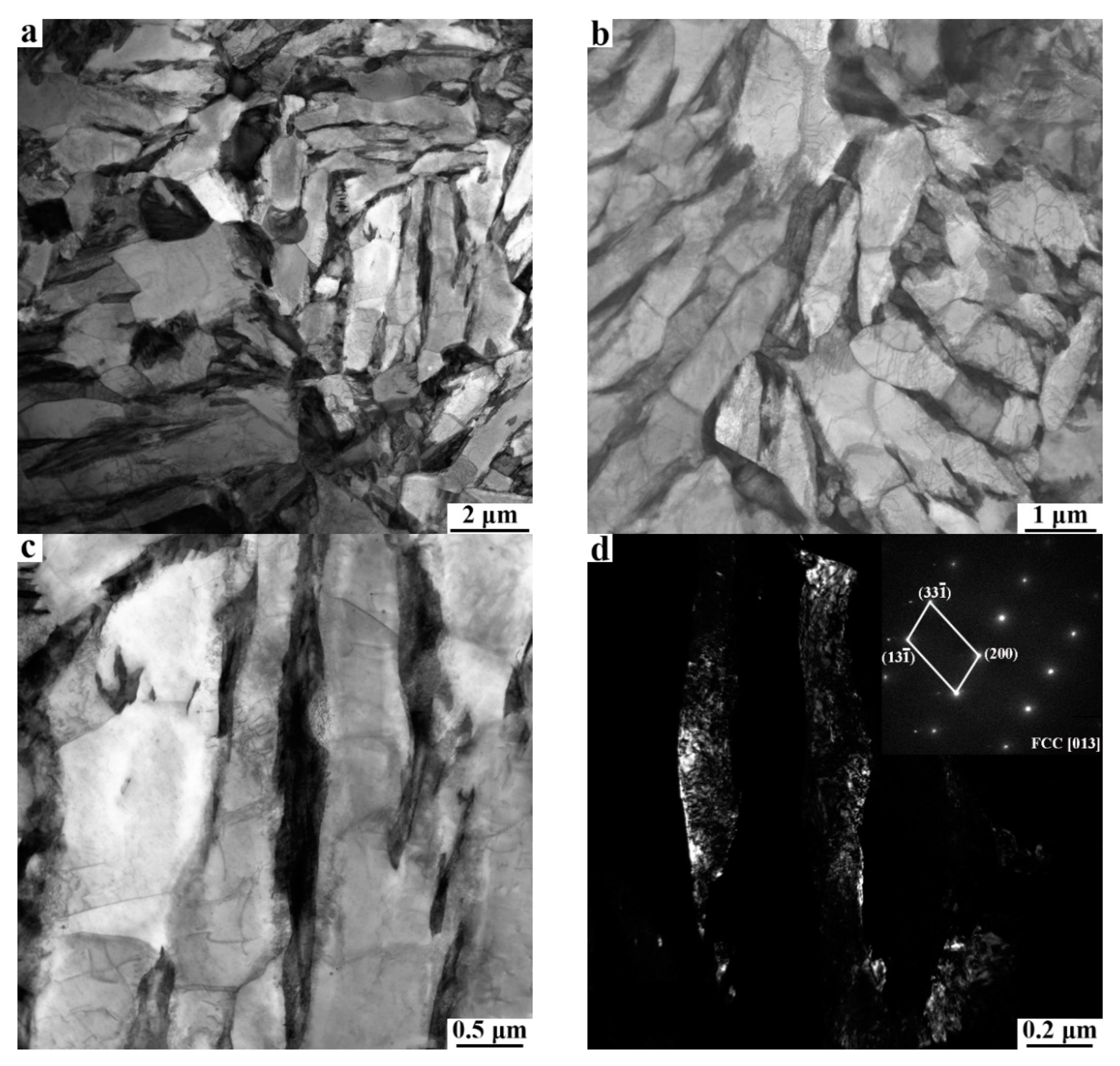
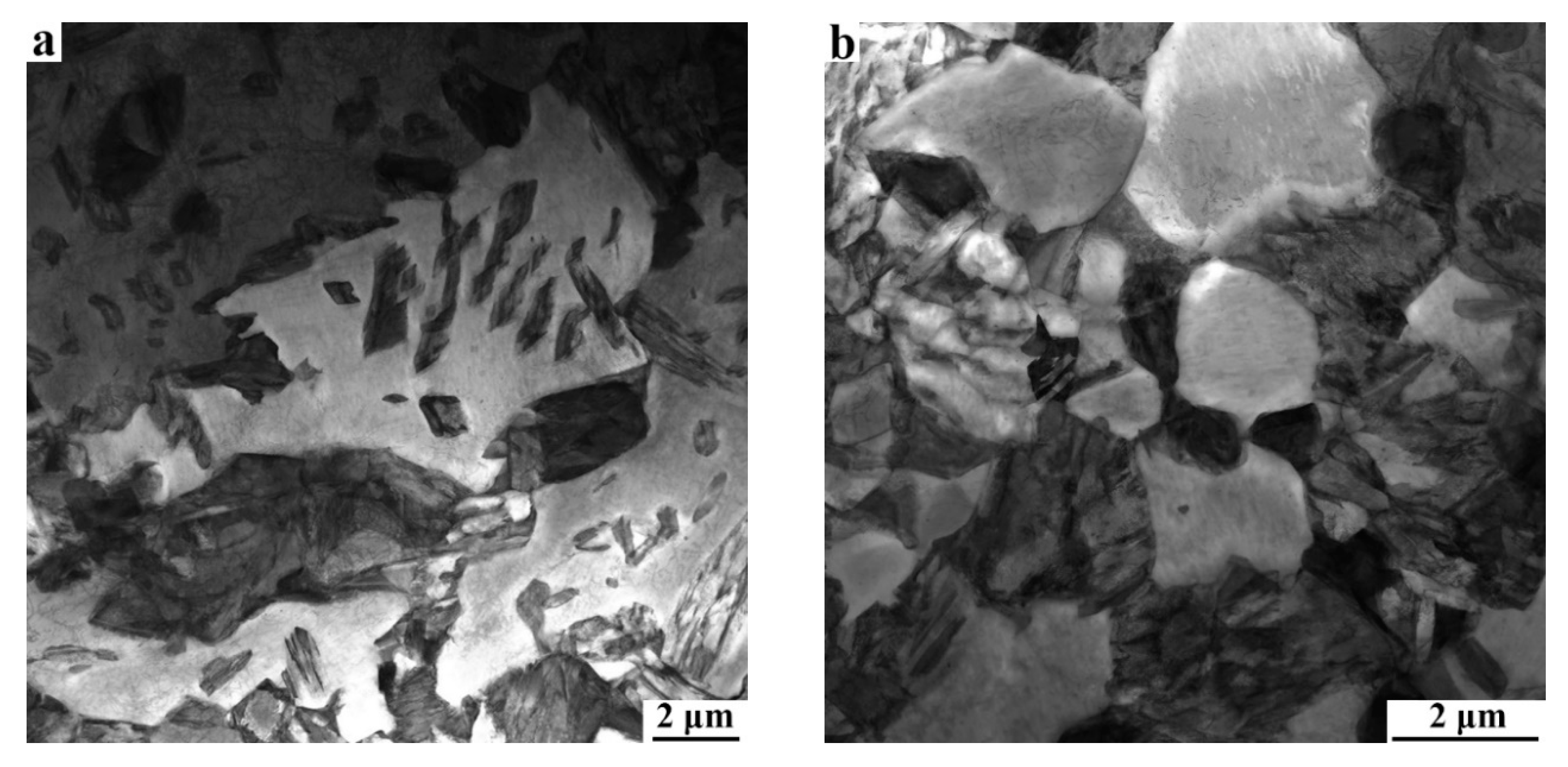

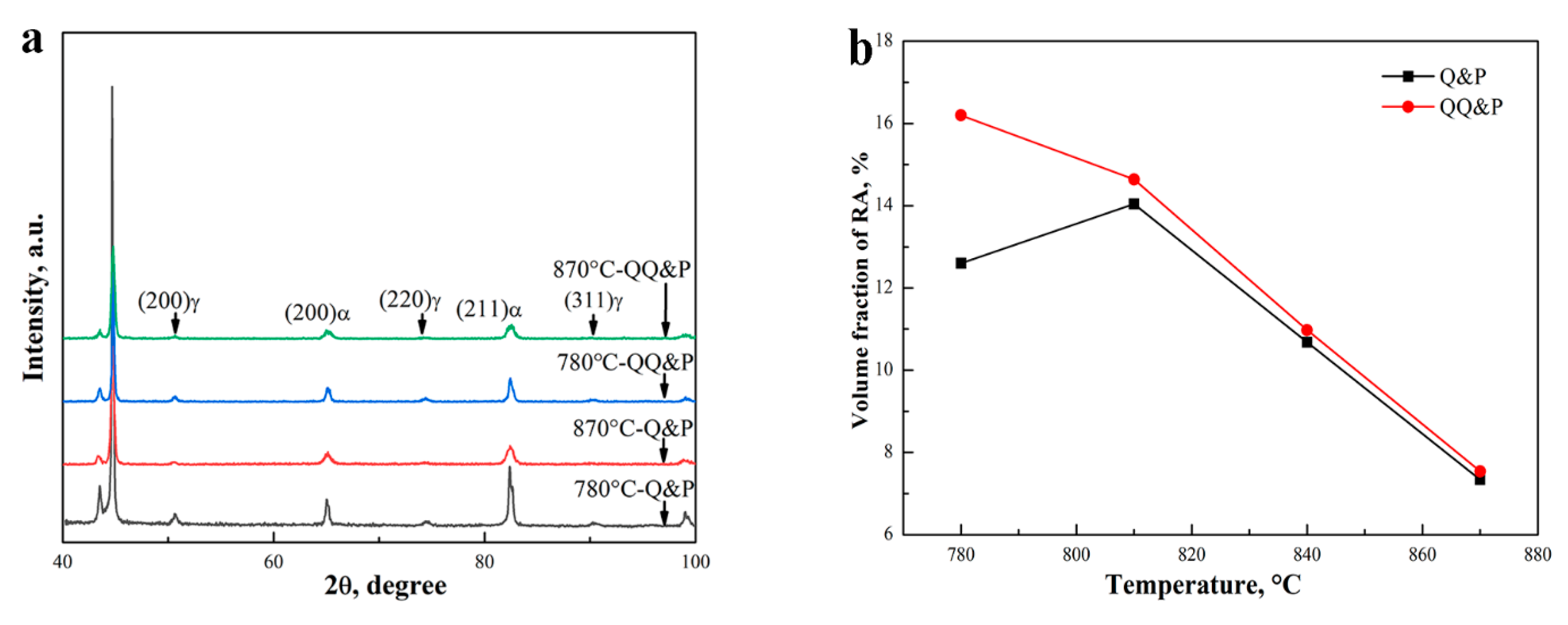
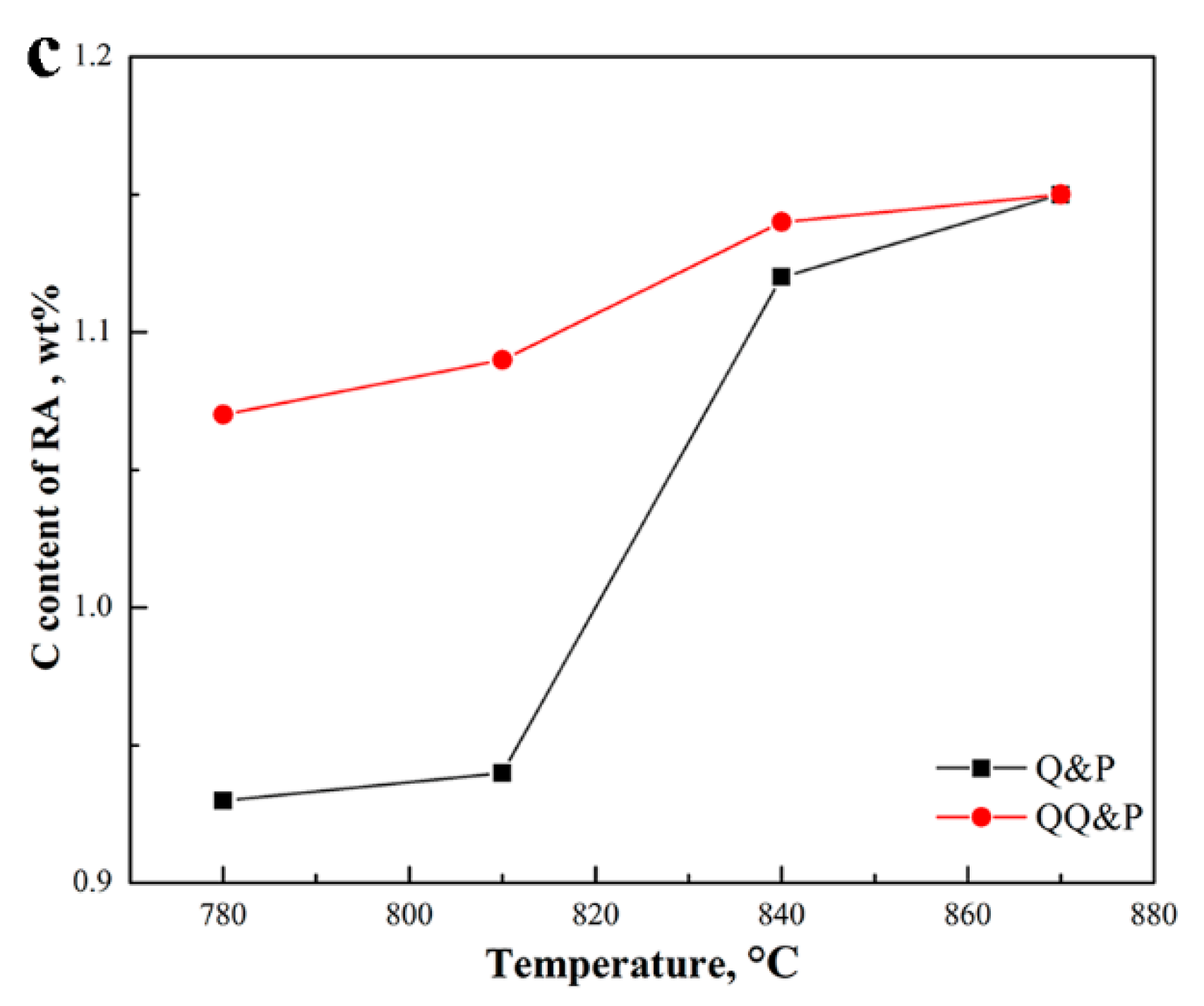

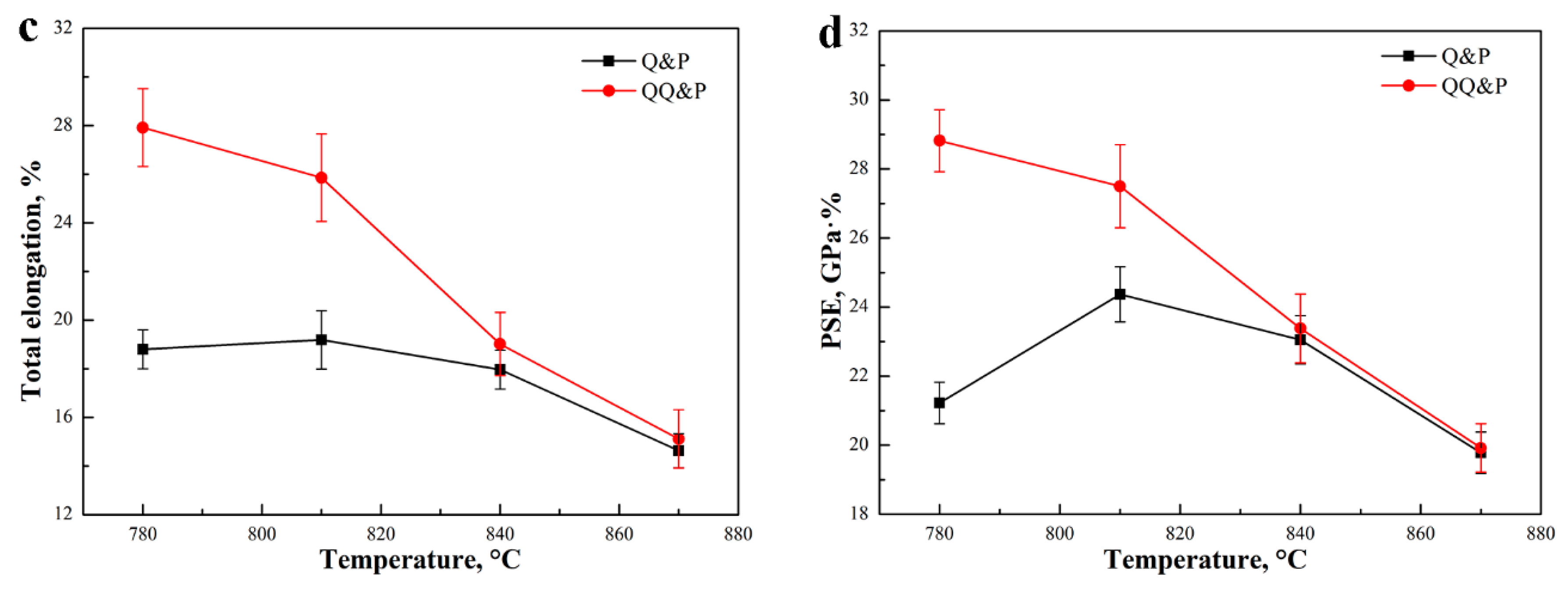

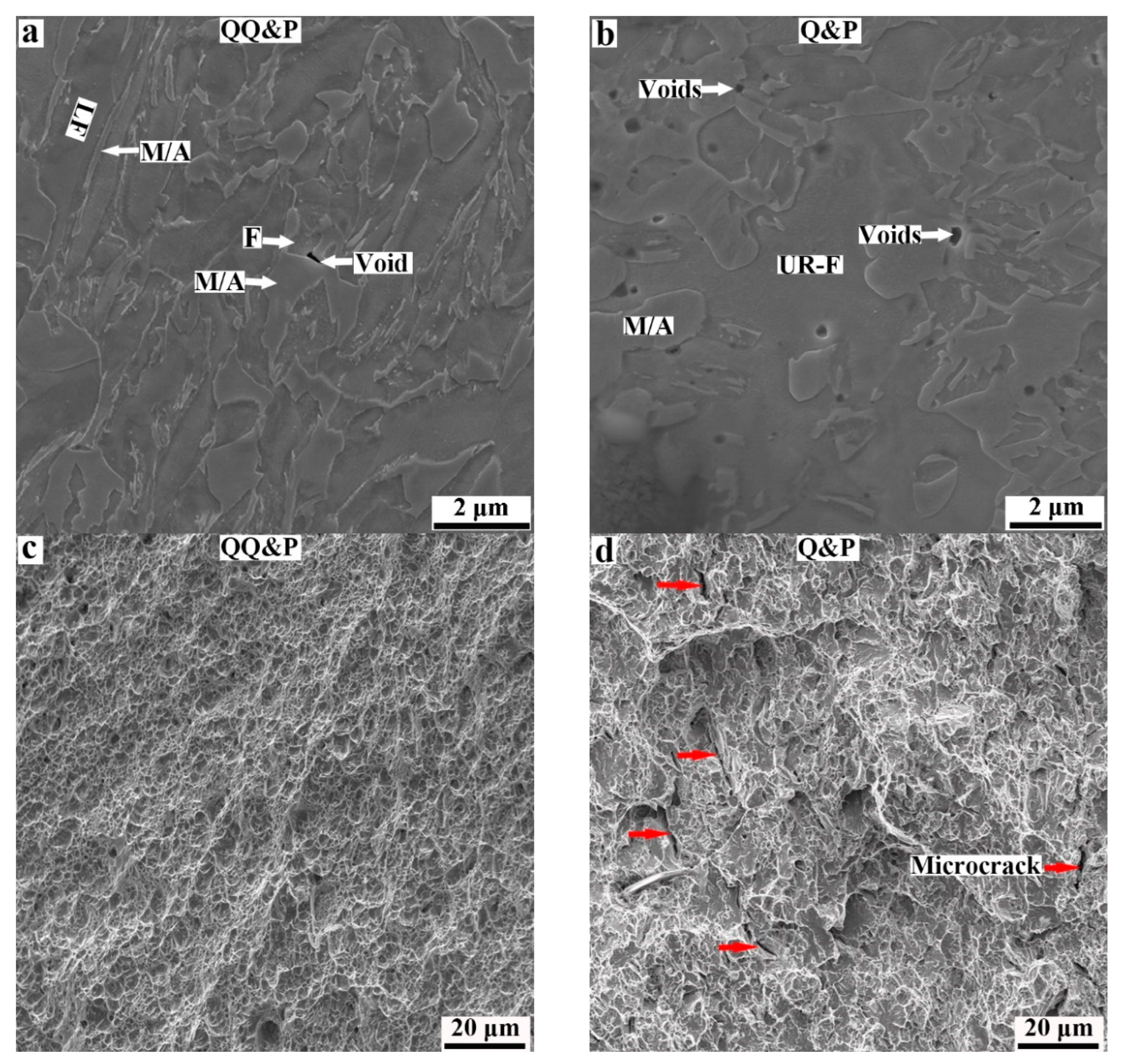
| C | Si | Mn | P | S | Ti | N | Al | Fe |
|---|---|---|---|---|---|---|---|---|
| 0.21 | 1.69 | 1.94 | 0.008 | 0.0013 | 0.02 | 0.0039 | 0.04 | Balanced |
| Sample | Uniform Plastic Deformation Stage | Necking Stage |
|---|---|---|
| 810 °C-QQ&P | ε < 0.178 | 0.178 < ε < 0.207 |
| 810 °C-Q&P | ε < 0.137 | 0.137 < ε < 0.156 |
Publisher’s Note: MDPI stays neutral with regard to jurisdictional claims in published maps and institutional affiliations. |
© 2022 by the authors. Licensee MDPI, Basel, Switzerland. This article is an open access article distributed under the terms and conditions of the Creative Commons Attribution (CC BY) license (https://creativecommons.org/licenses/by/4.0/).
Share and Cite
Xu, D.; Cheng, Y.; Yang, G.; Zhao, G.; Bao, S. The Influence of Annealing Temperature on the Morphology of Structures and the Mechanical Properties of Prequenching—Quenching and Partitioning Steel. Materials 2022, 15, 4156. https://doi.org/10.3390/ma15124156
Xu D, Cheng Y, Yang G, Zhao G, Bao S. The Influence of Annealing Temperature on the Morphology of Structures and the Mechanical Properties of Prequenching—Quenching and Partitioning Steel. Materials. 2022; 15(12):4156. https://doi.org/10.3390/ma15124156
Chicago/Turabian StyleXu, Deming, Yuanyao Cheng, Gengwei Yang, Gang Zhao, and Siqian Bao. 2022. "The Influence of Annealing Temperature on the Morphology of Structures and the Mechanical Properties of Prequenching—Quenching and Partitioning Steel" Materials 15, no. 12: 4156. https://doi.org/10.3390/ma15124156





